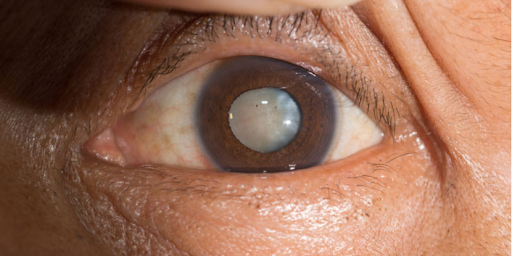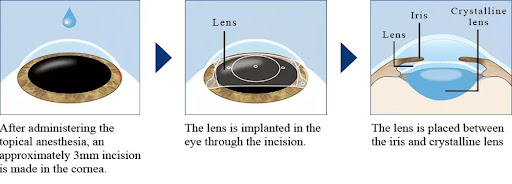Seeing the world’s beauty in a blur and fading lenses is the harsh reality of millions of people affected by cataracts. This condition clouds the eyes’ lens, impairing vision and hindering the pleasure of clear sight.
But do not fret; Eyeonce Eye Clinic is ready to help you address cataracts. With our cutting-edge technologies and expert eye doctors, Paik Dong Won, Head Director, and Jung Sae Rom, Medical Director, you will have a more precise and sharper vision.
What are cataracts?
Cataracts occur when the lens of the human eye, which is responsible for focusing and adjusting incoming light onto the retina, becomes clouded. This clouding hinders the passage of light and disrupts the formation of a clear, well-defined image on the retina. When this happens, your vision becomes blurry and obscured, as if viewing the world through a haze.
What are the different types of cataracts?
Typically, cataracts can affect anyone, but they are more common among older adults. There are different types of cataracts which are the following:
- Age-related cataracts – This cataract is the most common and tends to occur gradually due to natural aging. As we age, the proteins in our lenses can clump together, resulting in areas of cloudiness and compromising our vision.
- Congenital cataracts – Some unlucky people are born with this eye condition. However, some develop cataracts during childhood due to genetic factors, infection during pregnancy, or certain medical conditions.
- Traumatic cataracts – This type of cataracts form due to physical eye injuries, such as a blow to the eye or penetrating the eye trauma. The trauma’s impact can damage the lens and lead to clouding.
- Secondary cataracts – Certain factors, such as long-term use of corticosteroid medications, radiation exposure, or underlying medical conditions like diabetes, can increase the risk of developing cataracts.
At Eyeonce Eye Clinic, we uncover the cause and type of cataracts our patients have so we can give them the safest and the best treatment option possible.
What are the symptoms of cataracts?
Like any other eye condition, cataracts can manifest various symptoms, each of which can significantly impact our vision. Here are some common symptoms of cataracts to look out for:
- Blurry vision like looking through a fogged-up window – Cataracts make our vision appear hazy or foggy. This blurriness makes it extremely challenging to see details clearly and can ultimately affect our everyday activities, such as reading, driving, or recognizing faces.
- Double or multiple vision even with just one eye – Cataracts can lead to the perception of double or multiple images in one or both eyes. It happens when the light entering the eye gets scattered or refracted irregularly due to the clouded lens. As a result, the brain receives conflicting signals, leading to the perception of overlapping or duplicated images.
- Halos around light and improved vision indoors or at night – Cataracts can cause the light to scatter as it passes through the clouded lens, resulting in the appearance of halos or circles and light sources. These halos may be particularly noticeable when looking at lights, such as street lights and headlights. Additionally, individuals with cataracts may experience improved vision in dimly lit environments or indoors, as the reduced light intensity can compensate for the clouded lens.
- Temporary improved near vision without reading glasses – Cataracts can sometimes improve near vision, leading to seeing objects up close without reading glasses. This phenomenon occurs when the cataracts temporarily change the shape of the lens, altering the focusing ability. However, as the cataract progresses, near vision may deteriorate further.
It is important to note that these symptoms can vary in severity and impact individuals differently. You should consult with your eye doctors, such as the ones we have at Eyeonce Eye Clinic, for proper guidance and knowledge.
Cataract Surgery at Eyeonce Eye Clinic
As an established eye clinic in South Korea, Eyeonce Eye Clinic follows the correct procedures to safely and effectively remove the clouded lens and restore clear vision.
- Incision – This small and self-healing circular incision is made on the anterior side of the lens, which minimizes the need for sutures and promotes faster healing.
- Emulsification and Removal – An ultrasound probe is carefully inserted into the incision to break up and emulsify the cataract lens. The fragmented lens is then gently suctioned out of the eye, allowing for its complete removal. Our doctors at Eyeonce Eye Clinic perform this step with great precision to minimize the trauma to the surrounding tissues.
- Intraocular Lens (IOL) Implantation – Once the cataract lens is removed, Intraocular Lens (IOL), a clear artificial lens, is implanted into the lens capsule. The IOL permanently replaces the natural lens, restoring clear vision.
- Residue Removal and Completion – After securely placing the IOL, any remaining residue or particles are thoroughly removed from the eye. Our surgeons at Eyeonce Eye Clinic ensure the incision is clean and properly closed.
Our ophthalmologists at Eyeonce Eye Clinics perform cataract surgeries using state-of-the-art equipment and ensure that they prioritize the patient’s safety, comfort, and optimal visual outcomes. Moreover, our eye doctors evaluate each patient’s condition thoroughly and tailor the specific surgical approach, ensuring personalized care and the best possible treatment outcomes.
Consultation process at Eyeonce Eye Clinic
- If you suspect that you have cataracts, schedule a consultation with Eyeonce Eye Clinic.
- During the consultation, our ophthalmologists will take your medical history, ask about your symptoms, and run a series of tests and examinations to identify your condition.
- After taking your medical history and conducting the exam, our eye doctors will recommend a custom-fitted course for your needs.
Frequently Asked Questions
Yes. It is one of the most commonly performed surgeries worldwide and is considered a safe, routine procedure with a high success rate.
This eye condition is commonly associated with aging. However, factors such as family history, diabetes, smoking, prolonged sun exposure, certain medications, and eye injuries can contribute to the development of cataracts.
The need for glasses after cataract surgery depends on various factors, such as the type of IOL implanted and your visual needs. Some eye doctors recommend individuals wear glasses for certain activities, such as reading small print or correcting astigmatism.
Conclusion
It is indeed difficult for individuals affected with cataracts to do everyday activities. But with the proper guidance of expert ophthalmologists at Eyeonce Eye Clinic, it becomes easy to address this eye condition. Eyeonce offers comprehensive cataract evaluation and surgical services, ensuring our patients receive optimal visual outcomes. Book an appointment today to start your journey to a clearer and sharper vision!



